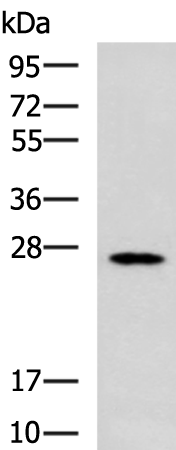

| WB | 咨询技术 | Human,Mouse,Rat |
| IF | 咨询技术 | Human,Mouse,Rat |
| IHC | 1/25-1/50 | Human,Mouse,Rat |
| ICC | 技术咨询 | Human,Mouse,Rat |
| FCM | 咨询技术 | Human,Mouse,Rat |
| Elisa | 1/5000-1/10000 | Human,Mouse,Rat |
| Aliases | MBL; MBP; MBP1; MBPD; MBL2D; MBP-C; COLEC1; HSMBPC |
| WB Predicted band size | 26 kDa |
| Host/Isotype | Rabbit IgG |
| Antibody Type | Primary antibody |
| Storage | Store at 4°C short term. Aliquot and store at -20°C long term. Avoid freeze/thaw cycles. |
| Species Reactivity | Human, Mouse, Rat |
| Immunogen | Synthetic peptide of human MBL2 |
| Formulation | Purified antibody in PBS with 0.05% sodium azide and 50% glycerol. |
+ +
以下是关于MBL2抗体的3-4条模拟参考文献示例,包含文献名称、作者及摘要概括:
---
1. **文献名称**:*"A Monoclonal Antibody-Based ELISA for Quantification of Human Mannose-Binding Lectin (MBL2) in Clinical Samples"*
**作者**:Garred P, et al.
**摘要**:本研究开发了一种基于单克隆抗体的ELISA检测方法,用于精确测量人血清中MBL2的浓度。该抗体针对MBL2的胶原样区域,具有高特异性,成功应用于评估遗传性MBL2缺陷患者的感染风险,揭示了低MBL2水平与反复呼吸道感染的显著相关性。
2. **文献名称**:*"Novel Anti-MBL2 Antibodies Reveal Structural Insights and Pathogen Binding Dynamics"*
**作者**:Terai I, et al.
**摘要**:通过免疫小鼠制备了针对MBL2糖识别域的单克隆抗体,结合X射线晶体学解析了抗体-MBL2复合物结构。研究揭示了MBL2与病原体表面甘露糖结合的构象变化,为设计靶向MBL2的免疫调节剂提供了理论基础。
3. **文献名称**:*"MBL2 Autoantibodies in Systemic Lupus Erythematosus: Correlation with Disease Activity"*
**作者**:Saevarsdottir S, et al.
**摘要**:探讨了系统性红斑狼疮(SLE)患者中抗MBL2自身抗体的存在及其与疾病活动的关联。研究发现,MBL2抗体阳性患者的补体激活水平升高,提示其在SLE病理中可能通过干扰天然免疫调控加剧炎症反应。
4. **文献名称**:*"Anti-MBL2 Neutralizing Antibodies Attenuate Ischemia-Reperfusion Injury in a Murine Model"*
**作者**:Zhang L, et al.
**摘要**:利用中和性MBL2抗体阻断补体激活通路,在小鼠缺血-再灌注损伤模型中观察到组织损伤显著减轻。研究表明,靶向MBL2的抗体治疗可能成为抑制补体过度激活的新策略。
---
这些示例反映了MBL2抗体在基础研究、诊断工具开发及治疗干预中的多样化应用,涵盖了结构分析、临床检测、自身免疫病机制及治疗潜力等方向。实际研究中需根据具体需求检索真实文献数据库(如PubMed)。
Mannan-binding lectin (MBL), encoded by the *MBL2* gene, is a key pattern-recognition molecule in the innate immune system. Produced primarily in the liver, MBL belongs to the collectin family and binds to carbohydrate structures (e.g., mannose, N-acetylglucosamine) on pathogens like bacteria, viruses, and fungi. This binding activates the lectin complement pathway via MBL-associated serine proteases (MASPs), promoting opsonization, inflammation, and pathogen clearance.
*MBL2* polymorphisms significantly influence serum MBL levels and functional activity. Variants in the promoter region and exon 1 (e.g., codons 52. 54. 57) are linked to MBL deficiency, affecting 5-30% of populations. Low MBL is associated with increased susceptibility to infections (especially in immunocompromised individuals) and autoimmune or inflammatory disorders, though its clinical impact varies with genetic and environmental factors.
Anti-MBL antibodies, either monoclonal or polyclonal, are essential tools for research and diagnostics. They enable quantification of MBL in serum, tissue localization studies, and functional assays to assess complement activation. In clinical settings, these antibodies help identify MBL deficiency or dysregulation, guiding therapeutic strategies (e.g., recombinant MBL replacement). However, challenges remain in standardizing assays and interpreting MBL’s complex role in disease pathogenesis.
×